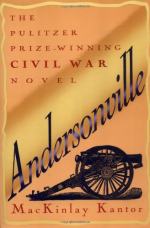[For a more particular description of the Hospital I must refer my reader to the testimony of Professor Jones, in a previous chapter.]
Certainly this continent has never seen—and I fervently trust it will never again see—such a gigantic concentration of misery as that Hospital displayed daily. The official statistics tell the story of this with terrible brevity: There were three thousand seven hundred and nine in the Hospital in August; one thousand four hundred and eighty-nine—nearly every other man died. The rate afterwards became much higher than this.
The most conspicuous suffering was in the gangrene wards. Horrible sores spreading almost visibly from hour to hour, devoured men’s limbs and bodies. I remember one ward in which the alterations appeared to be altogether in the back, where they ate out the tissue between the skin and the ribs. The attendants seemed trying to arrest the progress of the sloughing by drenching the sores with a solution of blue vitriol. This was exquisitely painful, and in the morning, when the drenching was going on, the whole hospital rang with the most agonizing screams.
But the gangrene mostly attacked the legs and arms, and the led more than the arms. Sometimes it killed men inside of a week; sometimes they lingered on indefinitely. I remember one man in the Stockade who cut his hand with the sharp corner of a card of corn bread he was lifting from the ration wagon; gangrene set in immediately, and he died four days after.
One form that was quit prevalent was a cancer of the lower one corner of the mouth, and it finally ate the whole side of the face out. Of course the sufferer had the greatest trouble in eating and drinking. For the latter it was customary to whittle out a little wooden tube, and fasten it in a tin cup, through which he could suck up the water. As this mouth cancer seemed contagious, none of us would allow any one afflicted with it to use any of our cooking utensils. The Rebel doctors at the hospital resorted to wholesale amputations to check the progress of the gangrene.
They had a two hours session of limb-lopping every morning, each of which resulted in quite a pile of severed members. I presume more bungling operations are rarely seen outside of Russian or Turkish hospitals. Their unskilfulness was apparent even to non-scientific observers like myself. The standard of medical education in the South—as indeed of every other form of education—was quite low. The Chief Surgeon of the prison, Dr. Isaiah White, and perhaps two or three others, seemed to be gentlemen of fair abilities and attainments. The remainder were of that class of illiterate and unlearning quacks who physic and blister the poor whites and negros in the country districts of the South; who believe they can stop bleeding of the nose by repeating a verse from the Bible; who think that if in gathering their favorite remedy of boneset they cut the stem upwards it will purge their patients, and if downward it will vomit them, and who hold that there is nothing so good for “fits” as a black cat, killed in the dark of the moon, cut open, and bound while yet warm, upon the naked chest of the victim of the convulsions.




